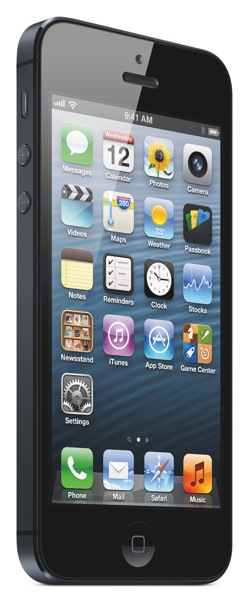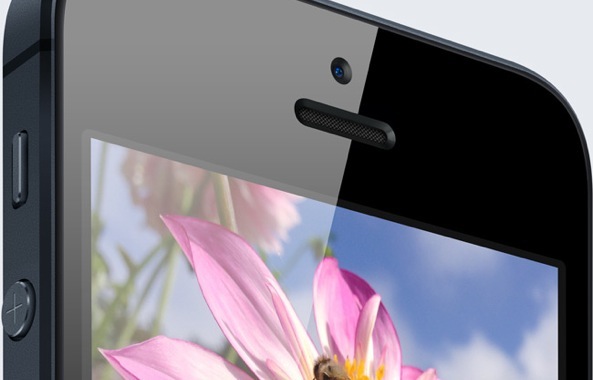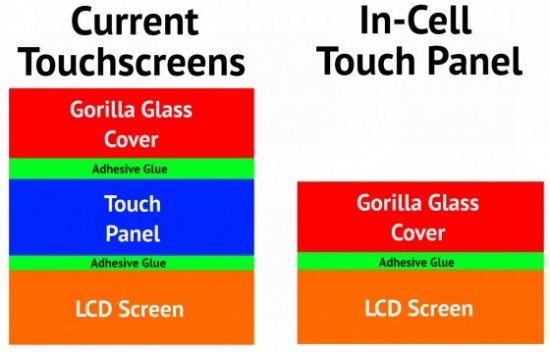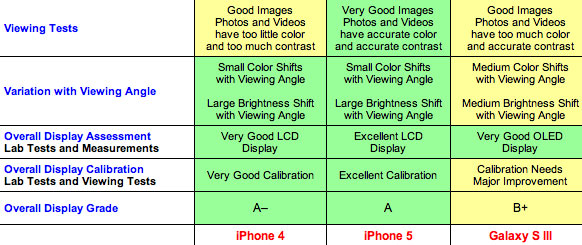Display experts DisplayMate put the iPhone 5 display through its paces and walked away pretty impressed, ranking it the best smartphone display they have ever tested. A lengthy analysis confirms that Apple improved upon pretty much every aspect of the iPhone 4/4S display. No longer are colors undersaturated and brightness doesn’t drop as much when looking at the iPhone 5 from side.
Moreover, the display on the iPhone 5 has excellent calibration plus accurate color and contrast. Overall, DisplayMate rates the iPhone 5 display as “A” versus “A-” for the iPhone 4 and “B+” for the Galaxy SIII…
According to DisplayMate’s findings, the OLED display Samsung used on the Galaxy SIII is a “very good OLED display” that, however, exhibits “medium” color and brightness shifts with viewing angles. In comparison, the iPhone 4 and 5 show “small” color and brightness shifts with viewing angles.
I think this comes as a given to anyone who has ever compared the iPhone’s LCD IPS display to Samsung’s OLED display. Though colors pop and are more vibrant, they tend to be oversaturated a bit. More importantly, OLED suffers from substantial color and brightness drops when viewed from angles other than having been seen head-on.
DisplayMate notes sums it up nicely (via MacRumors):
Based on our extensive Lab measurements the iPhone 5 has a true state-of-the-art accurate display – it’s not perfect and there is plenty of room for improvements (and competitors) but it is the best Smartphone display we have seen to date based on extensive Lab measurements and viewing tests.
Another important feat making the iPhone 5’s display way more pleasurable to look at: it has significantly lower screen reflection. This, in part, is due to advances in LCD technology, from thinner Corning Glass 2 to in-cell assembly technology which eliminates a layer and fuses the touch sensors directly into the panel.
It means less light refraction and the overall image that appears to be closer to your eyes, as if it were directly painted on the glass front.
The iPhone 4 and 4S Retina display reflects approximately about 8.1 percent of the light that bounces off of it versus 6.1 percent for the iPhone 4 (7.1 percent for the Galaxy SIII). This means the iPhone 5 display is easier to see in bright light or direct sunlight.
The iPhone 5 also exhibits a markedly improved color gamut: it’s “essentially perfect” at about 104 percent of standard. Compare this to only 64 percent of what color gamut should have been on the iPhone 4 or the “too large” gamut of 139 percent of standard on the Galaxy SIII.
The iPhone 5 has a Very Good display calibration, but it is not quite as accurate as the Excellent calibration on new iPad because its Intensity Scale Gamma is a bit too high, which upsets both the image contrast and color accuracy somewhat. It is still probably more accurate than any display you own, unless you have a new iPad.
Here’s another chart.
It should be also noted that the iPhone 4 shows a little too blue color temperature.
No matter how you look at it, the iPhone 5 display is not just about being taller (but not wider), measuring four inches diagonally or packing in 18 percent more pixels. It’s about display and assembly technologies that combined make a huge difference to the quality of the images and how you experience and interact with your content.
If you held an iPhone 5 in your hand, I’m curious as to whether or not you’d agree with DisplayMate’s assessment?




